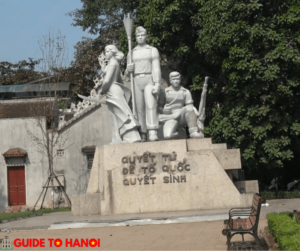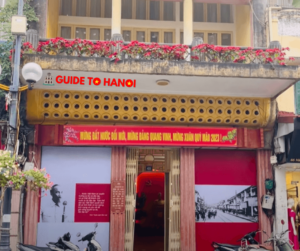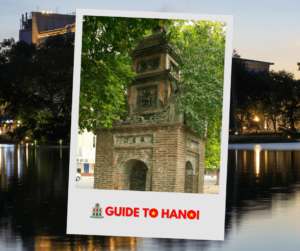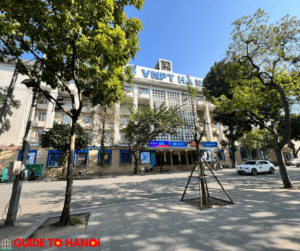Imperial Citadel of Thang Long
Greetings, intrepid explorers! If you find yourself in the charming city of Hanoi, prepare to embark on a historical journey that will transport you back in time.
Our destination? The magnificent Imperial Citadel of Thang Long is a treasure trove of past tales – and a UNESCO World Heritage Site!
A Stroll Through Time: Origins of the Citadel
Let’s rewind the clock to the 11th century when the Imperial Citadel of Thang Long entered the historical stage.
Built by the Ly Dynasty, this architectural marvel has withstood the test of time, witnessing centuries of dynasties, conflicts, and cultural shifts.
Unveiling the Layers: Architectural Marvels
Step into a realm where ancient architecture meets timeless elegance.
The Imperial Citadel boasts a harmonious blend of various styles, including Chinese and Southeast Asian influences.
Marvel at the intricately carved details, majestic gates, and the aura of regality that permeates every corner of this UNESCO World Heritage Site.
Mystery of the Forbidden City: Inside the Imperial Enclosure
Behold the heart of the Citadel – the Imperial Enclosure. Venture into a world shrouded in mystery, where emperors once held court and made pivotal decisions.
Explore the remnants of palaces, halls, and pavilions that echo with the whispers of a bygone era.
Dragons and Turtles: Legends Unveiled
Prepare to be enchanted by the mythical creatures guarding the Citadel.
From dragons gracing the entrance gates to turtles bearing inscriptions of ancient wisdom, every stone tells a tale.
Discover the folklore and symbolism that infuse the Imperial Citadel with a magical aura.
Attractions inside the Imperial Citadel
Here’s a concise overview of each attraction inside the Imperial Citadel of Thang Long:
Archaeological Site 18 Hoàng Diệu Street:
This site within the citadel showcases meticulously excavated artifacts, providing a glimpse into the daily lives of the citadel’s former inhabitants.
It serves as an archaeological treasure, offering tangible connections to the past.
Hanoi Flag Tower
Built in 1812 during the Nguyen Dynasty, the Hanoi Flag Tower symbolizes resilience.
Visitors can climb to its top for panoramic views of Hanoi, gaining a unique perspective on the city’s historical and contemporary landscape.
Main Gate (Đoan Môn)
The majestic entrance to the Imperial Citadel, Đoan Môn, is adorned with intricate details.
As the gateway to the Forbidden City during imperial rule, it invites visitors into a bygone era of regal ceremonies and historical significance.
Kinh Thiên Palace
Kinh Thiên Palace was once the main hall for crucial ceremonies and state affairs at the citadel’s heart.
Although now in ruins, it echoes the grandeur of imperial Vietnam, offering a compelling exploration of the country’s political and cultural history.
Dragon Steps
The Dragon Steps are a visually striking pathway adorned with dragon motifs.
Symbolic of Vietnamese mythology, these steps provide a unique and immersive experience, intertwining artistry with the cultural significance of dragons in Vietnamese heritage.
North Gate (Cửa Bắc, or Bắc Môn)
The North Gate, also known as Cửa Bắc or Bắc Môn, is a significant entrance to the Imperial Citadel.
Its historical importance and architectural design make it a noteworthy stop for visitors exploring the citadel’s vast grounds.
Building D67 and Bunker
Building D67 and its associated bunker offer a glimpse into more recent history.
They were used during the Vietnam War by the People’s Army of Vietnam from 1954 to 1975 as the headquarters; it serves as a stark reminder of the citadel’s multifaceted role over the years.
The site provides insight into the challenges faced by the citadel in the 20th century.
The Military Operation Bunker T1 of the General Staff of the Vietnam People’s Army
This historical gem was pivotal during the Vietnam War, also known as the American War in Vietnam.
Initiated in the latter part of 1964, the construction aimed to establish a strategic military headquarters for the Vietnamese freedom fighters.
The underground displays feature remnants from the war, including military uniforms and maps.
The compound encompasses tactical briefing rooms equipped with telephones that were once used for communication with President Ho Chi Minh.
Time Traveler’s Delight: The Archaeological Pit
For those with a penchant for archaeology, the Citadel’s Archaeological Pit is a must-visit.
Unearthed artifacts reveal the secrets of daily life in ancient times, offering a tangible connection to the people who once called this citadel home.
Citadels and Chill: Thang Long Water Puppet Theatre
After immersing yourself in history, take a breather with a unique cultural experience.
Adjacent to the Imperial Citadel lies the Thang Long Water Puppet Theatre, where traditional Vietnamese water puppetry comes to life.
It’s a whimsical way to cap off your historical escapade.
Book a ticket and skip the line here!
Insider Tips: Navigating the Imperial Citadel
Before you embark on your adventure, here are some insider tips to ensure a seamless experience.
Wear comfortable shoes for exploring the vast grounds, bring a hat and sunscreen for the sunny days, and don’t forget your camera – you’ll want to capture every moment of this journey through time.
So, fellow time traveler, are you ready to unravel the mysteries and bask in the grandeur of the Imperial Citadel of Thang Long?
Prepare for an expedition that combines history, culture, and a dash of wit – the perfect recipe for an unforgettable Hanoi escapade!

| Category | Details |
|---|---|
| Location | Hanoi, Vietnam |
| Constructed by | Ly Dynasty (11th century) |
| Meaning of “Thang Long” | Soaring Dragon |
| Architectural Style | A blend of Chinese and Southeast Asian influences |
| Entrance Fee | 30,000 VND/person ($1.5); Students: 15,000 VND; Children (under 15): Free |
| UNESCO Status | World Heritage Site |
| Noteworthy Feature | Water Puppet Theatre nearby |
| Attraction | Description |
|---|---|
| Archaeological Site 18 Hoàng Diệu Street | A treasure trove revealing relics from various dynasties, providing insights into ancient Vietnamese architecture and history. |
| Hanoi Flag Tower | A culturally significant landmark, spared during French colonial rule, offering panoramic views and standing on the foundation of the Forbidden City’s outer gate. |
| Main Gate (Đoan Môn) | The archway to Kinh Thiên Palace serves critical ceremonial roles, with a history dating back to the Lý dynasty, and is adorned with intricate masonry. |
| Kinh Thiên Palace | The primary relic of Hanoi’s Ancient Citadel showcases old foundations, Dragon Steps, and stone dragon sculptures—a masterpiece of Vietnamese architectural heritage. |
| Dragon Steps | Stone dragon sculptures from the Lê dynasty, considered a masterpiece of Vietnamese art, are located at the front entrance of Kinh Thiên Palace. |
| Rear Palace (Hậu Lâu) | Also known as the Northern Palace, a structure built during the Nguyễn dynasty, revealed foundations from the Lý, Trần, and Lê dynasties through excavations. |
| North Gate (Cửa Bắc) | The last standing gate from the Nguyễn dynasty, featuring embellished brick and stone construction, with cannon marks from the 1882 Battle for the Hanoi Citadel. |
| Building D67 and Bunker | Constructed in 1967, Building D67 was the headquarters during the Vietnam War and is now a museum exhibiting tools and artifacts from that era. |
How much is the entrance fee for Thang Long Imperial Citadel?
The entrance fee for the Thang Long Imperial Citadel is 30,000 VND per person.
Who built the Thang Long Citadel?
The credit for crafting the Thang Long Citadel goes to the Ly Dynasty, who laid the foundation stones in the 11th century.
These visionary architects left a legacy that continues to captivate visitors today.
What is decoding the Imperial Citadel of Thang Long?
“Decoding the Imperial Citadel of Thang Long” is a fascinating exploration that involves unraveling the historical, cultural, and symbolic layers of this ancient fortress.
It’s an immersive journey for those who want to delve deep into the secrets held within its walls.
What does Thang Long mean in Vietnamese?
“Thang Long” translates to “The Soaring Dragon” in Vietnamese.
This poetic name captures the essence of the citadel’s majesty and the mythical aura associated with dragons in Vietnamese culture.
How much does it cost to go to the Imperial Citadel Hanoi?
For a wallet-friendly journey through time, the entrance fee for the Imperial Citadel is just 30,000 VND per person (approximately USD 1.5).
Students enjoy a discounted rate of 15,000 VND, while young time-travelers under 15 can step into history for free.
Address:
- 19c Hoàng Diệu, Điện Biên, Ba Đình, Hà Nội
Contact:
Opening Hours:
- Daily: 8:00–17:00
- Monday: Closed.
Entrance Fee:
- 30,000 VND




